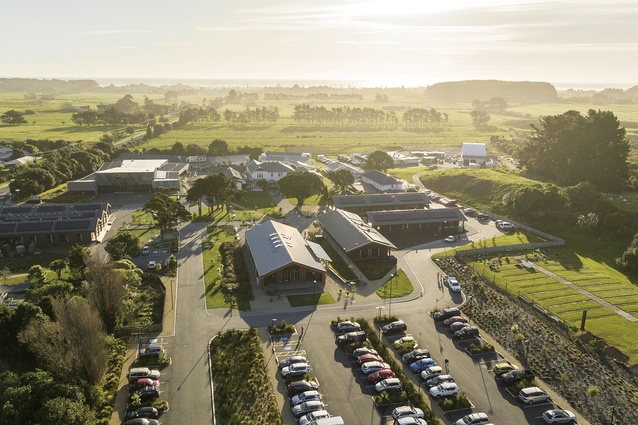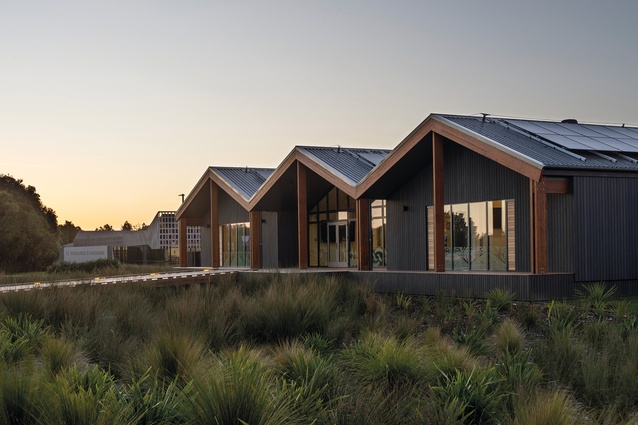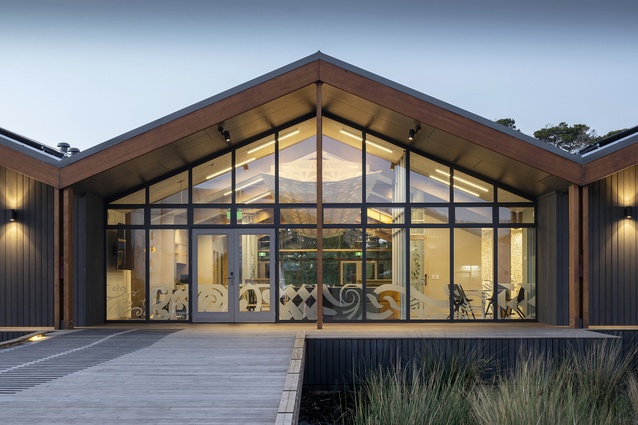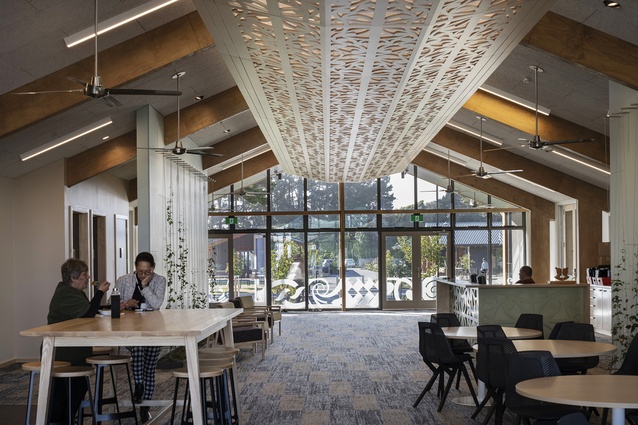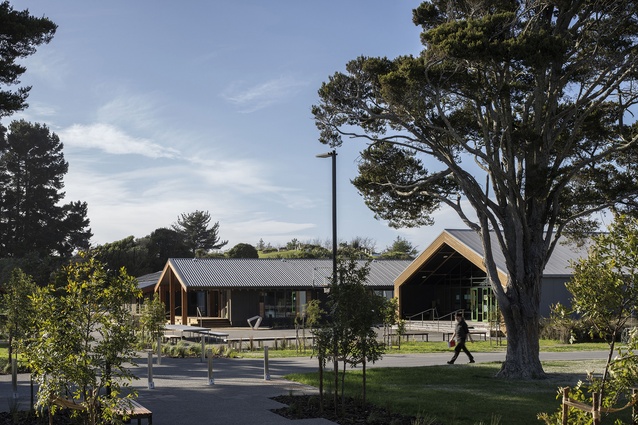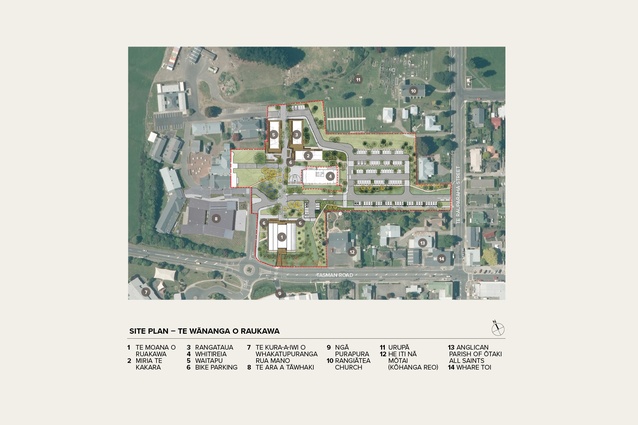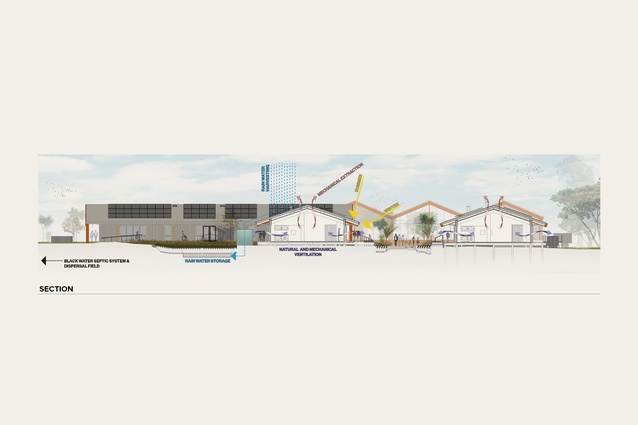Deeply tau: Pā Reo
Much has changed since my last visit to the Ōtaki-based wānanga during the filming of Te Ara a Tāwhaki for the Whakaata Māori television series The Drawing Board in April last year.
The former construction site across the road is now a lushly vegetated and thriving wetland, accommodating the latest additions to the rich collection of buildings that make up Te Wānanga o Raukawa. From the original re-purposed administration offices and classroom blocks to the newly crafted building projects, every addition to the wānanga from its inception in the early 1980s has contributed greatly to its evolution, representing the culmination of some 50 years of intergenerational strategic thinking and planning.
Tennent Brown Architects’ Pa Reo, consisting of Te Moana o Raukawa, Miria te Kakara, Rangataua and Waitapu, is the latest architectural implementation to the life of the campus and, of all the architecturally aesthetic additions to the wānanga (there are now three), it is the most understated. Comprising four buildings in total, its subdued, natural material palette and softened gable roof forms are completely without the formal complexity of the diagonal external screening of Te Ara a Tāwhaki or the exuberant timber triple-diamond shapes, cladded screen and embossed concrete of Ngā Purapura. The buildings are, instead, modest and unassuming and, within a wider eclectic mix, all four appear deeply tau, comfortably settled into their surrounding context.
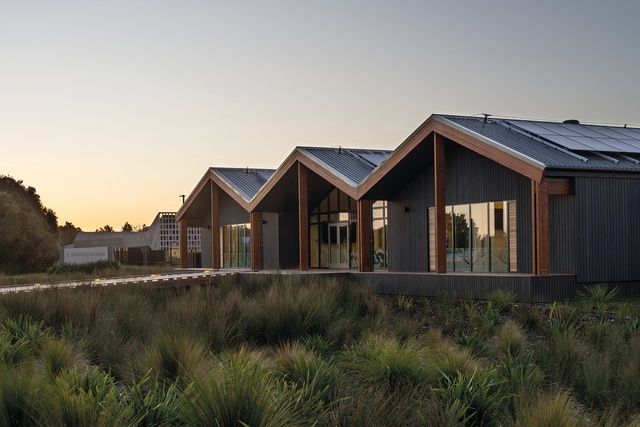
The Tasman Road entrance to the first part of the new facility is via an elevated pedestrian bridge, spanning the large vegetated wetland. The setback of mixed native grasses mirrors Ngā Purapura’s grassed and harakeke frontage, giving the main road an expansive, open feel before you enter the building. The use of water as a designed threshold upon entry and exit to the complex is both a legible cultural reference to whakanoa (removing tapu) for visitors to the wānanga and also a reminder of the life of the site and its surrounding ecology. From here, the visual depth and permeability of the glazed façade on either end of the central building create the perception of a transitional, open-ended space, providing a strong axis and staged waharoa gateway into the campus interior.
Once you are inside, the large, filigreed tāhuhu suspended centrally overhead reinforces the axial orientation of a processional path, supported by directionally patterned carpet tiles drawing you into the interior. Soft furnishings and informal workspaces, including a shared kāuta kitchen, create focused areas of diverse spaces. Internal spaces and walls are modulated by highly visible, exposed crosslaminated timber (CLT) structural portals with wall linings in between the five-metre spans: a feature typical to all four buildings.
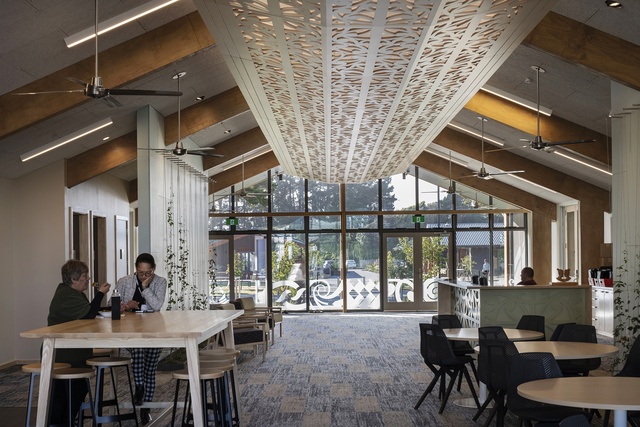
The conjoined buildings to either side are both office and administration team workspaces. Due to their functional necessities, these areas are separate and discrete, although well connected visually through glazed partitioning, with kaimahi staff, manuhiri visitors and tauira students able to access the main space and shared kāuta/kai preparation area to the left of the central building space. These purpose-built workspaces are allocated to wānanga kaimahi and kaiwhakaako teachers, who, for many years, have worked out of more-modest and less well- equipped, although well-loved, areas of the wānanga. The same building model module is repeated across the wānanga for the remaining three buildings that comprise Pā Reo.
As you enter the main landscaped area of the campus, Tennent Brown’s mannered exterior aesthetics begin to reveal a more utilitarian and functional (performative) feel. Metal, profiled cladding, exposed roof-mounted photovoltaic (PV) panels and stand-alone timber-screened plant rooms, along with small water-retention areas and watertreatment zones, are evident. Services that would normally be hidden are more visually prominent than would be expected.
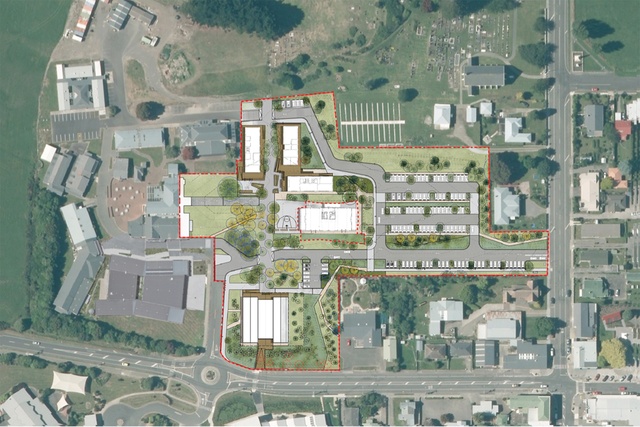
Landscape architecture by Wraight + Associates brings together the entire wānanga grounds, breaking with formalities. This starts at the car park off Te Rauparaha Street, which is relaxed and open, with generous planting to rain-garden water run-off and treatment areas. The landscaping moves through to the central ātea, then in and around the raised plinths of the new Pā Reo buildings, as if they were islands in a sea of green. The place feels alive, with its bushy grasses and shrubs visually dominating the hard surfacing. Offset planted beds and timber seating break up and soften the connection between akomanga classrooms, along the central axis pathway and ātea, towards the raised wahi tapu near Rangiātea Church.
Smaller spatial zones are designed around the existing mature vegetation and grassed parts of the central atea. This boulevard or transitional atea between spaces is important to the life of the wananga, as all buildings (both new and old) are orientated towards this important spatial arrangement of built-in access ramps and seating, served by the break-out kāuta of Miria te Kakara, all under eaves. Spatial use is diverse — from basketball half-court to collective study and kai tables, edges are blurred and materials and spaces overlap.
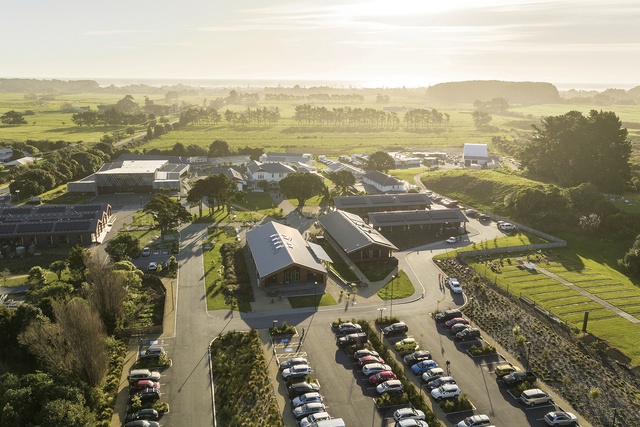
The three new akomanga buildings to the northernmost part of the site, although conforming to the orientational pathway, are loosely configured, more like a pre-European kāinga village or marae complex. The close proximity but slightly offset positioning of each whare provides a feeling of familial closeness and the organic boundaries are in keeping with the past whare mātua buildings to the west of the site, the older part of the wānanga.
It was Ngāi Tuhoe that originally introduced Tennent Brown to the Living Building Challenge (LBC), through the initial work of Ivan Mercep and Jasmax. And, although the projects that they were to work on with Tūhoe were not taken through to certification under the LBC, lessons gained from this experience were very clear. The LBC requires a type of “extreme” collaboration (Brown’s words) between all clients, partners, consultants and delivery specialists involved. Essentially, it involves a cultural ‘paradigm shift’ from the typical architect’s ‘boxticking’ approach for environmentally sustainable design (ESD).
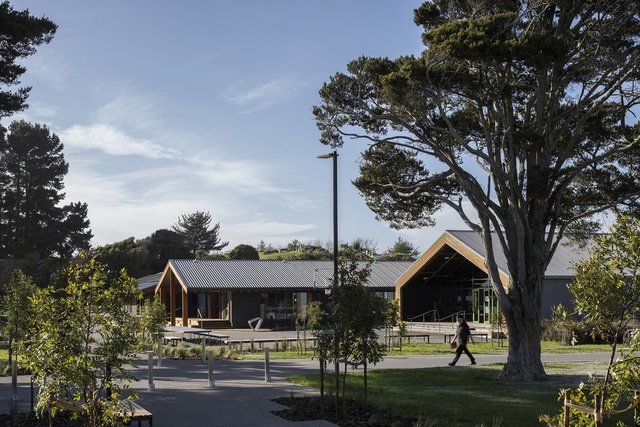
For Tennent Brown and Megan Wraight, this went beyond the ‘business as usual’ architectural practice activity. It also required an advocacy role, where the architect would need to take the lead to ensure the strong ideological focus and local project realities would bring everyone together under the LBC’s objectives. This would include the main contractors, subcontractors, suppliers and materials specialists. Under the LBC, the seven criteria or ‘petals’ of site, water, energy, health, materials, equity and beauty would need to be bought into, requiring an extensive commitment and upskilling to current methods of working and delivery. McMillan & Lockwood’s construction manager Ben Law (also part of wānanga whānau) knew the extra effort required to deliver the project under increased LBC scrutiny; it required the reduction of residual site waste — a net-zero environmental impact measure.
On Tennent Brown’s side, the LBC required a stringent research approach within the office to achieve all seven petals and the 20 criteria for eventual accreditation – especially around material specification and supply. Graduate architect Caitlyn Lee was the inhouse specialist, bringing much of her academic research into an LBC practice-specific compilation of a non-toxic materials matrix.
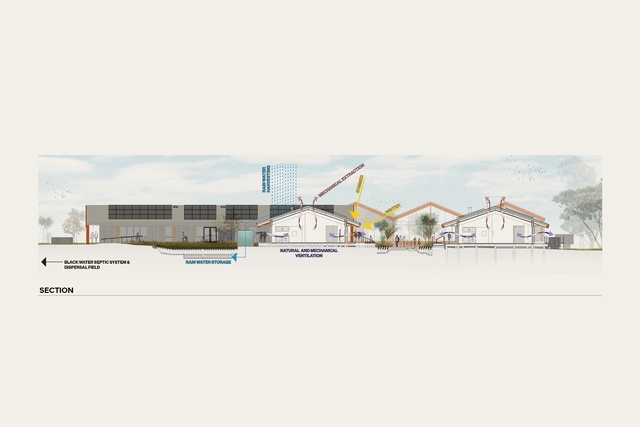
The next 10–12 months of occupancy and use will be critical to the certification process, whereby the project will need to verify ‘actual’ as opposed to ‘projected’ or predicted building performance in relation to environmental impact. The whānau as owner/occupier will need to grapple with this challenge, bearing in mind varying fluctuations in student numbers in relation to building usage and the demands of local climate conditions. Anecdotally speaking, the wānanga as a whole must already exceed the social impact criteria, which includes health and social justice through the generations of work building capability in the immediate community of Ōtaki and beyond. I have seen this firsthand in the far north, where many of our competent and upcoming leaders have been through the wānanga’s doors.
In 12 months’ time, the four new buildings will be included under the one certification, joining the one other significant LBC project nationally, Tūhoe’s Te Kura Whare (2014) in Tāneatua. By then, another project by Tennent Brown – The Living Pā at Te Herenga Waka Victoria University of Wellington – the first campus-built living building in the country, will be nearing completion (2024). All of these projects, to a large degree, have been implemented for and by Māori clients, iwi and students alike, building upon the 800+ registered projects under the LBC programme worldwide. With 34 currently certified via a long-dedicated process of performance assessment, six per cent of all certified living buildings internationally will be Māori-owned, occupied and operated.
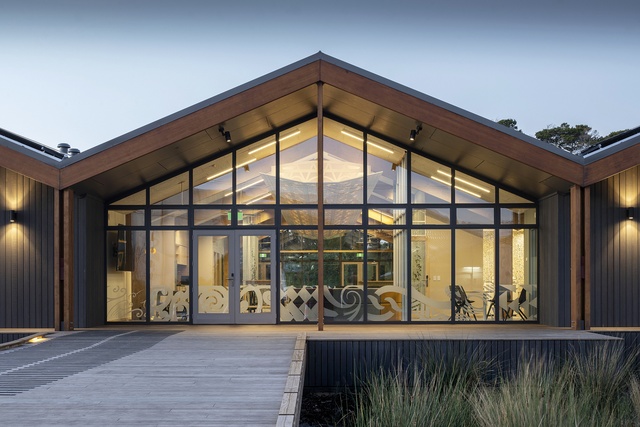
This alone is a strong statement in itself. It is one thing to embark on a project with aspirations of LBC certification as a client but another to find the deep commitment, resources, coordination and expertise required to see this most stringent of all ESD compliance fully through to completion. This is especially more challenging in a post-Covid construction industry inflationary environment.
According to Brown, the more the members of the whānau were able to understand the LBC in the context of their wānanga (and, indeed, wider Ōtaki), the more they were able to see the alignments to their own tikanga cultural values. At this point, ‘value engineering’ of LBC to the lesser ‘petal’ or ‘core’ status compliance was seen as a compromise. While Māori continue in all adversity to adhere to whakaaro taiao and holistic principles of ecological thinking and practice, in particular that of kaupapa kaitiaki, finding an appropriate alignment has always seemed to be the issue. Regardless of the origins and motivation for the Living Building Challenge, it might be said that it is only because of the LBC that there is now a bettersuited vehicle for the contemporary materialisation of aspects of kaitiaki-tanga.
Also, after 10–12 years, Tennent Brown and the whānau knew one another better. I have a sense that, with this project in particular, the architects have ‘listened’ deeply and responded appropriately. It might be said that the original architects of Te Wānanga o Raukawa started to design this project some 50 years ago as, indeed, our ancestors did, being the first designers, architects and engineers of this land.
As much as Ōtaki is a Māori town, the wānanga is, indeed, a Māori space. Now the wānanga is complete, the informal balance between nature, landscape and architecture is realigned.


